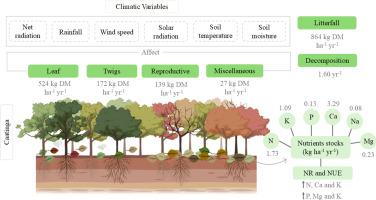当前位置:
X-MOL 学术
›
Agric. For. Meteorol.
›
论文详情
Our official English website, www.x-mol.net, welcomes your
feedback! (Note: you will need to create a separate account there.)
Deposition, seasonality and the effect of climate on litterfall and its components in Caatinga, a tropical dry forest: A five-year study
Agricultural and Forest Meteorology ( IF 5.6 ) Pub Date : 2025-06-01 , DOI: 10.1016/j.agrformet.2025.110662
Wilma Roberta dos Santos, Alexandre Maniçoba da Rosa Ferraz Jardim, Carlos André Alves de Souza, Luciana Sandra Bastos de Souza, Gabriel Ítalo Novaes da Silva, José Edson Florentino de Morais, George do Nascimento Araújo Júnior, Cleber Pereira Alves, Alanderson Firmino de Lucas, Lara Rosa de Lima e Silva, Pedro Paulo Santos de Souza, Leonor Patrícia Cerdeira Morellato, Thieres George Freire da Silva
Agricultural and Forest Meteorology ( IF 5.6 ) Pub Date : 2025-06-01 , DOI: 10.1016/j.agrformet.2025.110662
Wilma Roberta dos Santos, Alexandre Maniçoba da Rosa Ferraz Jardim, Carlos André Alves de Souza, Luciana Sandra Bastos de Souza, Gabriel Ítalo Novaes da Silva, José Edson Florentino de Morais, George do Nascimento Araújo Júnior, Cleber Pereira Alves, Alanderson Firmino de Lucas, Lara Rosa de Lima e Silva, Pedro Paulo Santos de Souza, Leonor Patrícia Cerdeira Morellato, Thieres George Freire da Silva

|
Litter production is an ecosystem process responsible for adding nutrients to the soil. In addition, litter contributes to increased soil fertility and respiration and prevents soil degradation and erosion. However, in the Caatinga around 40 % of the native vegetation has already been modified, resulting in the loss of this material. In this study, we evaluated the deposition and decomposition of litter, its relationship with meteorological variables, nutrient concentration, nutrient return and nutrient use efficiency in a dry forest in the semi-arid region of Brazil. Average litter production was 864.69 kg DM ha-1 year-1, with greater deposition during the dry season. The main component was the leaf fraction, which accounted for 61 % of the total litter. This fraction showed a negative correlation with global solar radiation (-0.70), net radiation (-0.75) and canopy temperature (-0.61). The remaining fractions (twigs, reproductive structures and miscellaneous items) cannot therefore be linked to the explanatory group, and present isolated effects. The average rate of decomposition was 1.60 year-1 and ranged from 0.14 to 3.99 year-1 over the five years of the evaluation, while nutrient return equalled litter production, especially for Ca2+ (39.4 kg ha-1 year-1), N (20.7 kg ha-1 year-1) and K+ (13.1 kg ha-1 year-1). Nutrient use efficiency was relatively high for P, Mg2+ and K+. Our results suggest that the Caatinga presents a unimodal seasonal pattern of litterfall, with greater production during rainier years and peaks in production during the transition between winter and autumn. Litter production led to an increase in organic matter in the soil, acting as a source of nutrients and protecting the soil from impacts caused by environmental conditions.
中文翻译:

热带干旱森林卡廷加的沉积、季节性和气候对凋落物及其组成部分的影响:一项为期五年的研究
凋落物产生是一个生态系统过程,负责向土壤中添加养分。此外,凋落物有助于提高土壤肥力和呼吸作用,并防止土壤退化和侵蚀。然而,在卡廷加,大约 40% 的原生植被已经被改造,导致这种材料的损失。在这项研究中,我们评估了巴西半干旱地区干旱森林中凋落物的沉积和分解,及其与气象变量、养分浓度、养分回报和养分利用效率的关系。平均产渣量为 864.69 公斤干物质公顷 -1 , -1 旱季沉积量更大。主要成分是叶子部分,占总凋落物的 61%。该分数与全球太阳辐射 (-0.70)、净辐射 (-0.75) 和冠层温度 (-0.61) 呈负相关。因此,其余的部分(树枝、生殖结构和杂项)不能与解释组联系起来,并呈现出孤立的效果。在评估的五年中,平均分解速率为 1.60 年 -1 ,范围为 0.14 至 3.99 年 -1 ,而养分回报等于凋落物产量,尤其是 Ca 2+ ( -1 每年 -1 39.4 公斤)、N(每年 20.7 公斤 -1 -1 )和 K + (每年 13.1 公斤 -1 -1 )。P、Mg 2+ 和 K + 的养分利用效率相对较高。我们的结果表明,卡廷加呈现出单峰的季节性凋落物模式,在多雨的年份产量较高,在冬季和秋季之间的过渡期产量达到峰值。 凋落物的产生导致土壤中有机物的增加,有机物是养分的来源,并保护土壤免受环境条件的影响。
更新日期:2025-06-01
中文翻译:

热带干旱森林卡廷加的沉积、季节性和气候对凋落物及其组成部分的影响:一项为期五年的研究
凋落物产生是一个生态系统过程,负责向土壤中添加养分。此外,凋落物有助于提高土壤肥力和呼吸作用,并防止土壤退化和侵蚀。然而,在卡廷加,大约 40% 的原生植被已经被改造,导致这种材料的损失。在这项研究中,我们评估了巴西半干旱地区干旱森林中凋落物的沉积和分解,及其与气象变量、养分浓度、养分回报和养分利用效率的关系。平均产渣量为 864.69 公斤干物质公顷 -1 , -1 旱季沉积量更大。主要成分是叶子部分,占总凋落物的 61%。该分数与全球太阳辐射 (-0.70)、净辐射 (-0.75) 和冠层温度 (-0.61) 呈负相关。因此,其余的部分(树枝、生殖结构和杂项)不能与解释组联系起来,并呈现出孤立的效果。在评估的五年中,平均分解速率为 1.60 年 -1 ,范围为 0.14 至 3.99 年 -1 ,而养分回报等于凋落物产量,尤其是 Ca 2+ ( -1 每年 -1 39.4 公斤)、N(每年 20.7 公斤 -1 -1 )和 K + (每年 13.1 公斤 -1 -1 )。P、Mg 2+ 和 K + 的养分利用效率相对较高。我们的结果表明,卡廷加呈现出单峰的季节性凋落物模式,在多雨的年份产量较高,在冬季和秋季之间的过渡期产量达到峰值。 凋落物的产生导致土壤中有机物的增加,有机物是养分的来源,并保护土壤免受环境条件的影响。


















































 京公网安备 11010802027423号
京公网安备 11010802027423号